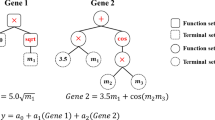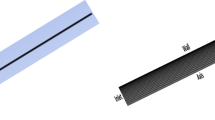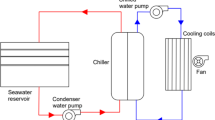Abstract
Most vapour compression refrigeration systems still operate under on–off control, although it is well known that the application of any other control method could result in improved COP. For that purpose, the present paper experimentally studies the use of adaptive fuzzy hybrid control and design of experiments techniques, as well as the application of the response surface methodology, in a 5-ton vapour compression system with a variable speed compressor and an electronic expansion valve. Evaporation temperature and evaporator overall conductance were found to be the most relevant input parameters to the fuzzy hybrid control system, where the optimal trajectory was sought without taking into account the elapsed time. Results have shown that the knowledge of the most relevant parameter of the system allowed for the control system to seek high COP zones. It has been found that this type of technique does not jeopardize the control performance, which remains robust.

















Similar content being viewed by others
Abbreviations
- A:
-
Scheme of the control related to the number of steps of the EEV
- B:
-
Scheme of the control related to the compressor speed
- COP:
-
Coefficient of performance (–)
- e(k):
-
Inlet error of the adaptive fuzzy PI control (A)
- ea(k):
-
Accumulated inlet error of the fuzzy PI control (A)
- ∆e(k):
-
Change in inlet error of the adaptive fuzzy PD control (B)
- ∆e :
-
Mean absolute change in inlet error of the adaptive fuzzy PD control (B)
- f e(k):
-
Estimated frequency (Hz)
- f r(k):
-
Real frequency (Hz)
- FREQ:
-
Frequency of compressor (Hz)
- IAE:
-
Integral of the absolute error value
- ITAE:
-
Integral of the absolute error value time weighted
- k :
-
Refer to instant of time
- KKv :
-
Adaptive mechanism of internal factor of the adaptive fuzzy PD control (B)
- k pc :
-
Gain of the fuzzy PI control (A)
- Kv :
-
Sensibility scale factor of the adaptive fuzzy PD control (B)
- N:
-
Negative set of the adaptive fuzzy PD control (B)
- \(\dot{m}_{r22}\) :
-
Refrigerant mass flow rate (kg/s)
- NEEV:
-
Number of steps of the electronic expansion valve (–)
- R :
-
Positive set of the adaptive fuzzy PD control (B)
- \(P_{1}\) :
-
Compressor suction pressure (kPa)
- \(P_{2}\) :
-
Compressor discharge pressure (kPa)
- \(P_{3}\) :
-
Condensation pressure (kPa)
- \(P_{4}\) :
-
Pressure measured downstream the electronic expansion valve (kPa)
- \(\dot{Q}_{{\text{ev}}}\) :
-
Cooling capacity (kW)
- ∆t:
-
Period of time (s)
- t a :
-
Settlement time period (s)
- \(T_{{\text{cd}}}\) :
-
Condensation temperature (°C)
- \(T_{{\text{ev}}}\) :
-
Evaporation temperature (°C)
- \(T_{1}\) :
-
Refrigerant temperature at the evaporator outlet (°C)
- \(T_{5}\) :
-
Water temperature at the evaporator outlet (°C)
- \(T_{8}\) :
-
Water temperature at the evaporator inlet (°C)
- \(\Delta T_{{\text{sc}}}\) :
-
Degree of subcooling (°C)
- \(\Delta T_{{\text{sh}}}\) :
-
Degree of superheat (°C)
- UA :
-
Heat exchanger conductance (kW/m2 K)
- U c :
-
Output signal of the fuzzy adaptive PD controller (B)
- U k :
-
Output signal of the fuzzy PI controller (A)
- U 2 :
-
Output signal to the actuator of the fuzzy PI controller (A)
- |Uc|:
-
Mean absolute exit signal of the fuzzy adaptive PI control (B)
- u(e):
-
Pertinence function inlet error of the adaptive fuzzy PI control (A)
- u(ea):
-
Pertinence function inlet error accumulated of the adaptive fuzzy PI control
- UA :
-
Heat exchanger overall conductance (kW/K)
- \(\dot{W}\) :
-
Power consumption (kW)
- Z:
-
Zero set of the adaptive fuzzy PD control (B)
- CCF:
-
Central composite design—face centred
- DOE:
-
Design of experiments
- EEV:
-
Electronic expansion valve
- FET:
-
Field effect transistor
- LN:
-
Mean large negative
- LP:
-
Large positive
- MN:
-
Medium negative
- MP:
-
Medium positive
- MSR:
-
Methodology of response surface
- N:
-
Negative
- P:
-
Positive
- PID:
-
Proportional integral derivative controller
- PLC:
-
Programmable logic controller
- QQR:
-
Optimal lineal quadratic control
- SISO:
-
Traditional control for one entrance and one exit
- SN:
-
Small negative
- SP:
-
Small positive
- TXV:
-
Thermostatic expansion valve
- Z, ZO:
-
Zero
References
Abernethy RB, Thompson JW (1980) Handbook: uncertainty in gas turbine measurements. Va. National Technical Information Service, Springfield
Aprea C, Mastrullo R, Renno C (2008) Fuzzy control of the compressor speed in a refrigeration plant. Int J Refrig 27(6):639–648
Bandarra Filho EP, Garcia FEM, Mendoza OSH (2011) Application of adaptive control in a refrigeration system to improve performance. J Braz Soc Mech Sci Eng 33:21–30
Box GEP, Draper NR (1987) Empirical model-building and response surfaces. John Wiley & Sons, New York
Box GEP, Hunter JS, Hunter WG (2005) Statistics for experimenters, 2nd edn. Wiley, New York
Chen W, Zhijiu C, Ruiqi Z, Yezheng W (2002) Experimental investigation of a minimum stable superheat control system of an evaporator. Int J Refrig 25(8):1137–1142
Dhar M, Soedel W (1979) Transient analysis of vapor compression refrigeration system: part I, mathematical model and part II, computer simulation. In: Proceedings of 15th international congress of refrigeration meeting Venice, Italy, pp 1035–1067
Dossat RJ, Horan TJ (2001) Principles of refrigeration, 5th edn. Wiley, Hoboken, NJ
Ekren O, Kucuka S (2010) Energy saving potential of chiller system with fuzzy logic control. Int J Energy Res 34(10):897–906
Ekren O, Sahin S, Isler Y (2010) Comparison of different controllers for variable speed compressor and electronic expansion valve. Int J Refrig 33:1161–1168
Higuchi K, Hayano M (1982) Dynamic characteristics of thermostatic expansion valves. Int J Refrig 5(4):216–220
Jia X, Tso CP, Chia PK (1995) A distributed model for prediction of the transient response of an evaporator. Int J Refrig 18(5):336–342
Jian-peng C, Jeong S, Jung Y (2014) Fuzzy logic controller design with unevenly-distributed membership function for high performance chamber cooling system. J Cent South Univ 7:2684–2692
Koury RNN, Machado L, Ismail KAR (2001) Numerical simulation of a variable speed refrigeration. Int J Refrig 24:192–200
Lenger MG, Jacobi AM, Hrnjak PS (1998) Superheat stability of an evaporator and thermostatic expansion valve. Air Conditioning and Refrigeration Center, University of Illinois Mechanical and Industrial Engineering Department, report ACRC TR-138, 1206 West Green Street, Urbana, IL 61801(217):333–3115
Marcinichen JB, Schurt LC, Melo C, Vieira LAT (2008) Performance evaluation of a plug-in refrigeration system running under the simultaneous control of compressor speed and expansion valve opening. 12th International Refrigeration and Air Conditioning Conference at Purdue
Mithraratne P, Wijeysundera NE (2002) An experimental and numerical study of hunting in thermostatic-expansion-valve-controlled evaporators. Int J Refrig 25(7):992–998
Myers RH, Montgomery DC (1995) Response surface methodology: process and product optimization using designed experiments. John Wiley & Sons, New York, NY
Oliveira V, Trofino Neto A, Hermes CJL (2011) A switching control strategy for vapor compression refrigeration systems. Appl Therm Eng 31:3914–3921
Outtagarts A, Haberschill P, Lallemand M (1995) Comportement dynamique d’un évaporateur de machine frigorifique soumis a` des variations de debit. In: Proceedings of 19th international congress of refrigeration, B2. La Haye, pp 413–420
Pinolla CF, Vargas JVC, Buiar CL, Ordonez JC (2015) Energy consumption reduction in existing HVAC-R systems via a power law controlling kit. Appl Therm Eng 82:341–350
Rajendran H, Pate M (1986) A computer model of the start-up transients in a vapor compression refrigeration system. In: International refrigeration and air conditioning conference, Paper 17. http://docs.lib.purdue.edu/iracc/17
Shunagquan S (2004) Performance representation of variable-speed compressor for inverter air conditioners based on experimental data. Int J Refrig 27:805–815
Schurt LC, Hermes CJL, Trofino-Neto A (2009) A model-driven multivariable controller for vapor compression refrigeration systems. Int J Refrig 32:1672–1682
Takagi T, Sugeno M (1985) Fuzzy identification of systems and its applications to modeling and control. IEEE Trans Syst ManCybern 15(1):116–132
Tsai C, Tsai K, Su C (2012) Cascaded fuzzy-PID control using PSO-EP algorithm for air source heat pumps. In: International conference on fuzzy theory and its applications (iFUZZY), Taichung, 16–18 Nov 2012
Vargas JVC, Parise JAR (1995) Simulation in transient regime of a heat pump with closed-loop and on-off control. Int J Refrig 18(4):235–243
Yasuda H (1994) Modeling of refrigeration cycle dynamics for air conditioner. Trans JSME 60(573):103–110
Acknowledgments
The authors gratefully acknowledge the support of CNPq, CAPES, FAPERJ and FAPEMIG.
Author information
Authors and Affiliations
Corresponding author
Additional information
Technical Editor: Francis HR Franca.
Rights and permissions
About this article
Cite this article
Bandarra Filho, E.P., Hernandez Mendoza, O.S., Moreno Garcia, F.E. et al. Energy conservation for refrigeration systems by means of hybrid fuzzy adaptive control techniques. J Braz. Soc. Mech. Sci. Eng. 38, 1753–1766 (2016). https://doi.org/10.1007/s40430-016-0538-2
Received:
Accepted:
Published:
Issue Date:
DOI: https://doi.org/10.1007/s40430-016-0538-2




